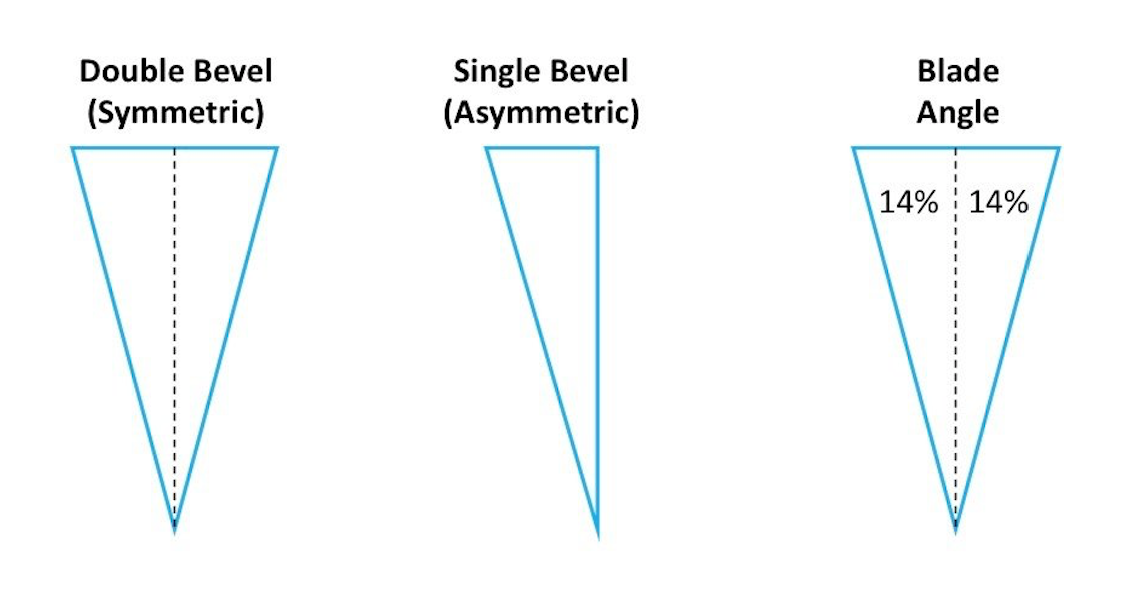
Japanese knives all tend to have a very specific meaning behind the name of each knife, in most cases, they are partly named to describe the blade, cutting technique, or type of food that the knife is used for.
There is one knife in particular that has seen its popularity grow exponentially in both Japan and the Western world in recent years and that is the Santoku knife. While this knife continues to become a staple in household and professional kitchens, many people have questioned what the term Santoku means?
The word Santoku means “three virtues” or “three uses” and its interpretation will vary depending on who you ask. These three virtues or uses can either mean the cutting style that the Santoku allows which is slicing, dicing, and mincing or it can also be a reference to the types of food that it is most suited to cut which are meat, fish, and vegetables.
The word Santoku has a very specific meaning that relates to its intended purpose as a Japanese chef's knife and in this article, we cover what Santoku means, where it originated from, and how you can interpret its meaning properly.
Table of contents
What Does Santoku Mean?
The Santoku bōchō (三徳包丁) can be specifically translated to mean three-virtues (knife) which is demonstrated by the etymology below:Etymology - 三徳 santoku, the three virtues, from 三 san: three + 徳 -toku: virtue
While three virtues is the literal meaning, many chefs or general knife users have tried to further translate this meaning over the years and describe the three virtues to also mean three uses or three purposes.
This is intended to describe the actual Santoku knife with three uses meaning the knife's cutting capability which is slicing, dicing, and mincing or it can also be described to mean the three food types for which this knife is most suited to cutting which is meat, fish and vegetables.
As you can see, this one word has been used to carry many different meanings or interpretations which can vary depending on who you ask or where you research it.
Is Santoku Japanese or Western?
The term Santoku originated in Japan however it’s unclear or unconfirmed whether it is meant to be a Japanese or Western term. While the word itself may appear to be Japanese and the origin of the word comes from Japan, it’s unclear whether this was intended to be a Japanese term.The reason for this is that the Santoku was designed to be the Japanese equivalent of a Western chef knife and took its inspiration from these Western models. Therefore, while the origin is clear, many users and chefs still argue that it's a Western-inspired word.
What Is a Santoku Knife?

A Santoku knife (from where the name is most commonly used) is a general-purpose knife that is designed to be the Japanese equivalent to a Western chef's knife. It does so by utilizing traditional Japanese designs and materials but also infuses some Western characteristics which we’ll cover shortly.
Since the late 1940s, the Santoku knife started to grow in popularity as an alternative to both a Japanese vegetable knife (Nakiri) and the Western chef's knife.
The Nakiri with its wide blade and pointed tip resembling a cleaver was very difficult for non-professional chefs to use whilst the large and pointed Western chef’s knife can also be considered difficult to use. As a result, the smaller Santoku with a minimal tip was created to fill this apparent need and allow users to comfortably and safely cook both Japanese and Western-style cuisine.
This hybrid knife with its general purpose use and global appeal has since gone on to become the most popular kitchen knife in Japan. It’s done so whilst also seeing increased popularity in Western society as a result of offering traditional Japanese design combined with Western characteristics.
Santoku Knife Characteristics
Below are just a few of the characteristics that make the Santoku knife unique whilst still holding universal appeal and we’ll point out which parts of this knife have Japanese influence and which parts also have some Western influence.It’s worth keeping in mind that many people refer to the Santoku as the younger cousin of a Western chef's knife as a result of some of the similarities between the two knife types and this is the primary reason why this knife is utilized by both Japanese and Western chefs.
Design

The blade of a Santoku knife is an easily distinguishable feature, it has a wide sheepsfoot blade that has a flat edge and no tip (the spine curves downwards to meet the edge). This lack of a sharp tip is one particular reason why this knife has become popular because many see it as a safety feature for home kitchens (especially those with young children).
The visual appearance and overall design of a Santoku knife are largely influenced by a Japanese style. Santoku knives are often made of a carbon-steel blend for the blade which allows these knives to be lighter, thinner, and to hold a sharper edge for longer periods of time.
Many of these knives are also formed from Damascus steel, this is a layered technique that forms a distinguished pattern on the outside of the blade. Damascus steel is not just used for visual appearance though and the process of using Damascus steel is also practical as it forms hard steel that can hold an edge for longer.
Bevel

The edge of the knife is the characteristic of a Santoku which is most closely related to that of a Western chef's knife. Traditional Japanese knives will have a single bevel edge, this means the knife has been ground to an angle on only one side of the blade to form the edge.
A Santoku can be manufactured to have a single bevel edge however, many are now manufactured to have a double bevel which forms a V-shaped edge. This means that the knife is sharpened on both sides of the blade to form an edge which is the method used by Western-style chef knives.
Whilst a Santoku can have either a single or double bevel edge, the angle with which it is sharpened most reflects the Japanese style and that is to have a much more acute angle for the edge. This results in a significantly sharper knife for the precise and thin cuts that are most associated with Japanese cuisine.
Size
The Santoku was initially designed to be an easier-to-use version of the Nakiri, a Japanese vegetable knife. The Nakiri with its cleaver-shaped design can be difficult for some people to use and therefore the Santoku has some of these characteristics like the wide blade with a flat edge but is an easier to handle size design.Most Santokus are 5” - 8” in blade length which is on the shorter side for a general-purpose knife, especially considering a Western chef knife is an average of 8” - 12” in length, however, the versatility of a Santoku means that it’s easy to use whilst also having modifications if needed (like a sharper tip, longer blade or slightly curved edge).
Summary
The Santoku knife is now one of the most popular and widely used kitchen knives worldwide with its Japanese and Western influence both evident. While the word Santoku literally means “three virtues” this meaning has loosely been extended over time.The word Santoku is more popularly referred to as meaning “three uses” which again has been further translated to either means that the Santoku knife has three cutting techniques (slicing, chopping, and dicing) or that it’s well suited to three types of food (meat, fish, and vegetables).
As a general-purpose knife, we are comfortable accepting that it can mean all of the above and while its origins lie in Japan, the Santoku knife is a marrying of two cultures with both Japanese and Western influence.
FAQs
Q: What is a Santoku knife?
A: A santoku knife, also known as a "Japanese Chef Knife"
Typically has a blade that is 6-inches long and made of steel
Has been around for well over one hundred years in Japan.
Popular because it offers versatility with the best properties of a knife, such as the ability to cut vertically or horizontally without having food stick to the blade and its sharp edge. The angle at which it cuts makes for dangerous hacking, yet still able to support gentle slicing.
Q: How do you use a Santoku knife?
A: With skilful use of the non-cutting edge of the blade, food can also be finely chopped using downward strokes that turn to an alternating position with one or two fingers on top of the blade to maintain a lighter pressure so as not to cut oneself.
Q: Can you rock a Santoku?
A: A santoku is not designed to rock really, as it is designed to slice.


